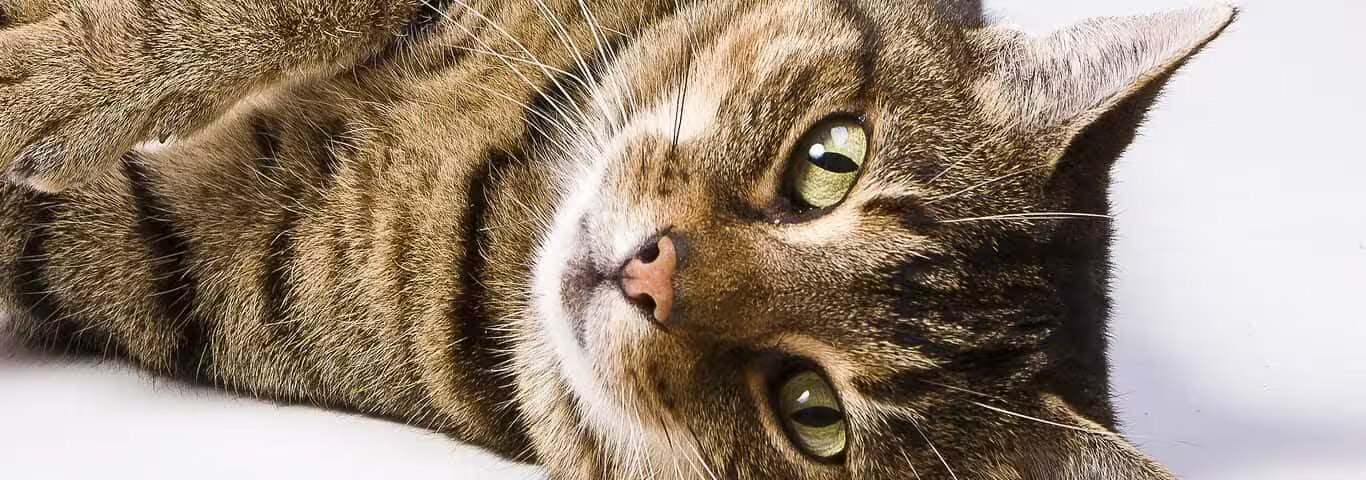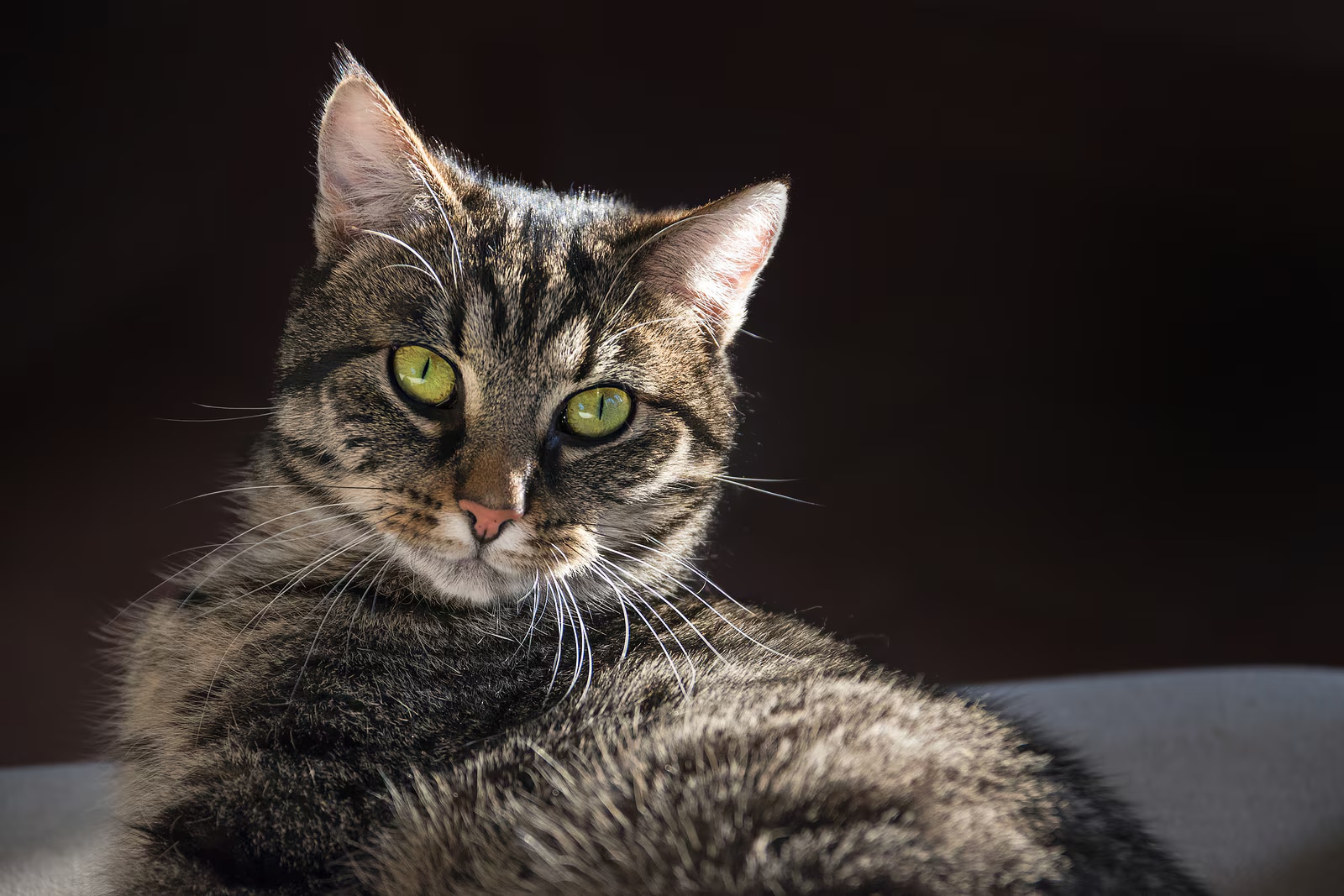They also have large heads and medium ears (sometimes with those cute tufts of hair), both slightly rounded, with a straight nose and firm chin and cheeks.
The European Shorthair has a firm, rounded body, but they are prone to tummy "pooches." Their coats are very sleek and shiny, especially with regular brushing, and they are conscientious self-groomers, a behavior that benefited them when they worked hard in dirty barns and fields across Europe.
Cat eyes have transfixed people for centuries, and the European Shorthair's hues are no exception. "The colors of cats' eyes have a remarkable range," explains the Cat Fanciers' Association. "The main colors of the eyes of cats are orange, copper, yellow, hazel, green, blue-green and blue. The pupil is always black. Eye color can be linked and influenced by the color of the cat's coat but that is not always the case." The European's amber hue is exceptionally beautiful, and for pedigreed cats, the odd-eyed trait is an accepted standard if amber is paired with blue.
One of the European Shorthair's most favorable qualities is her ability to adapt quickly to new environments, making her an ideal pet for households with small children and seniors, as well as with other cats, dogs and various pets. (Just be sure to keep small creatures like guinea pigs and hamsters out of your kitty's reach. After all, a cat's hunting instincts run deep.) She loves her pet parents and strives to please them, an aspect of her temperament that traces back to her days as a hard-working mouser.
Like all cats, the European loves to play and appreciates having a plethora of fun cat toys at her disposal. She's a very intelligent furry friend, so you'll want to keep her engaged mentally and physically. Cat food puzzles, for example, challenge your European and help her hone her predatory instincts in a constructive way.
As noted, European Shorthairs are great self-groomers, but she will need at least a weekly combing from you, as well as claw-trimming, teeth-brushing and the occasional cat bath. In order to keep her athleticism in top-top shape, choose a cat food that will provide her with optimum nutrients and flavor.
Despite being outgoing with human family members, the European Shorthair cat personality reveals itself as shy or timid, particularly around strangers. Providing her with a safe space in which to hide will help your nervous cat to feel more secure, as will socializing her with other people.
European Shorthairs have a predilection for the outdoors, but this is not always a safe option for your kitty or for the wildlife in your yard. You can indulge her love of the great outdoors by installing a high cat condo or perch near a secure, open window.
These days, the term "house cat" conjures images of a content, relaxed kitty who likes nothing more than to curl up in a cozy napping spot and have plenty of humans to shower her with affection. And while this is a pretty accurate depiction, that little fur baby of yours is a territorial hunter at heart.
In her early days, the European Shorthair made a name for herself in ancient Rome, and she tagged along with Roman invaders as they traveled across Europe. Her sharp intelligence and athletic hunting prowess made her an invaluable addition to legions across the continent. She was adept at protecting food supplies from rodents and other pests that threatened the soldiers' livelihood. From the early Roman settlements, the European Shorthair was revered for her hunting skills on the first modern farms as European life in the Middle Ages transitioned into an agrarian society.
The contemporary European Shorthair cat first appeared in Sweden as kitties with all of the best traits (friendly, playful, active), and the breed remains popular in Scandinavia. It's even the national cat of Finland.
Within pedigreed cat circles, confusion swirled around the breed's name because the European Shorthair and the British Shorthair were used interchangeably, despite the fact that the European was bred with different traits than her British, Celtic, Bär, and Exotic counterparts—the Persian even made its way into certain European breeds.
Interestingly, researchers who performed genetic testing on various cats around the world also discovered that "North American cats were closely linked to European cats," according to an article published in Genomics, confirming that the European domestic housecat made its way across the Atlantic with early North American settlers.
Breeders were interested in preserving the "Romanness" of the European, and in 1992, the Fédération Internationale Féline (FIFe), based in Luxemburg, recognized the European Shorthair as an official breed separate from other Shorthairs, and developed a set of breed standards.
Although the European Shorthair is the "pedigree version of the common housecat in Europe," according to Animal Planet, this breed, with her sleek coat, stealth hunting and sweet disposition, is anything but average.
Adopt a pet. Change a life.
Are you prepared to adopt a pet? Use these tools to make sure you are ready for the commitment.
Adopt a pet. Change a life.
Are you prepared to adopt a pet? Use these tools to make sure you are ready for the commitment.






















